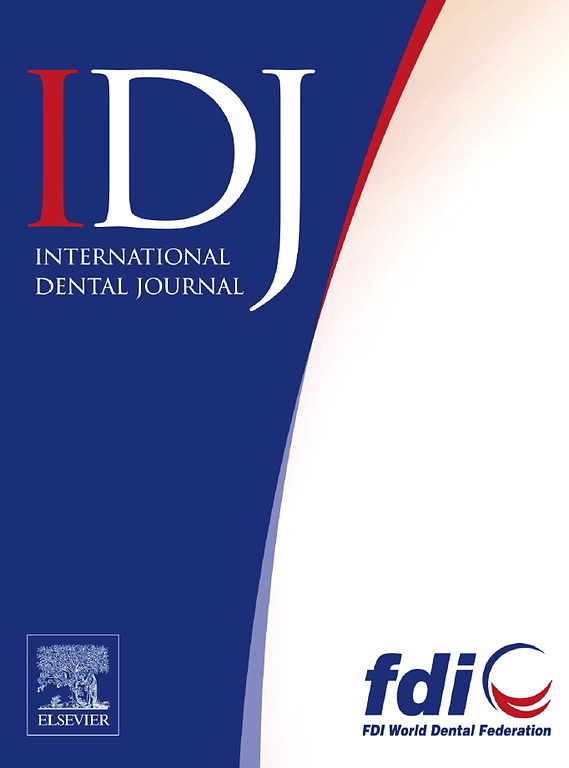纳米复合材料修复磨削对牙医有风险吗?
IF 3.2
3区 医学
Q1 DENTISTRY, ORAL SURGERY & MEDICINE
引用次数: 0
摘要
目的:评估短期吸入磨牙过程中释放的纳米颗粒对氧化应激和抗氧化能力指标的影响:评估短期吸入磨牙过程中释放的纳米颗粒对氧化应激和抗氧化能力指标的影响:在牙科工作室对 24 名健康志愿者进行暴露前后的检查。在牙科纳米复合材料研磨过程中,他们在测试室停留了 76.8 ± 0.7 分钟。使用个人纳米粒子采样器(PENS)监测每位受试者呼吸区域的个人气溶胶粒子暴露情况。在暴露前后收集呼出气体冷凝物(EBC)、血液和尿液样本,通过分光光度法测量一种氧化应激标志物,即硫代巴比妥酸活性物质(TBARS),以及两种抗氧化能力生物标志物,即铁还原抗氧化能力(FRAP)和还原型谷胱甘肽(GSH)。用肺活量和呼出一氧化氮分数(FeNO)来评估急性吸入接触的影响:牙科纳米复合材料磨碎物的平均质量为 0.88 ± 0.32 g。PENS 测得的可吸入颗粒和纳米颗粒的平均个体剂量分别为 380 ± 150 和 3.3 ± 1.3 μg。暴露后 EBC 和血浆中的氧化应激标志物 TBARS 没有明显增加。暴露后 EBC 中的抗氧化能力生物标志物 FRAP 和 GSH 也没有下降。62.5%的志愿者在接触后出现结膜充血,但肺活量测定或 FeNO 结果均未发现任何损害。没有发现测量的任何生物标志物与个人暴露相关,但发现与干扰因素(年龄、体重指数、高血压、血脂异常和环境污染参数)存在一些相关性:这项研究利用志愿者在研磨牙科纳米复合材料过程中生物液体中的氧化应激生物标志物和抗氧化能力生物标志物,证明这种强烈的短期暴露不会产生负面影响。不过,还需要进一步研究,以评估长期接触纳米复合材料的口腔医师和患者以及不同健康状况的人群的氧化应激情况。本文章由计算机程序翻译,如有差异,请以英文原文为准。
Are there Risks from Nanocomposite Restoration Grinding for Dentists?
Objectives
To evaluate the effect of short-term inhalational exposure to nanoparticles released during dental composite grinding on oxidative stress and antioxidant capacity markers.
Materials and methods
Twenty-four healthy volunteers were examined before and after exposure in dental workshop. They spent 76.8 ± 0.7 min in the testing room during grinding of dental nanocomposites. The individual exposure to aerosol particles in each participant´s breathing zones was monitored using a personal nanoparticle sampler (PENS). Exhaled breath condensate (EBC), blood, and urine samples were collected pre- and post-exposure to measure one oxidative stress marker, i.e., thiobarbituric acid reactive substances (TBARS), and two biomarkers of antioxidant capacity, i.e., ferric-reducing antioxidant power (FRAP) and reduced glutathione (GSH) by spectrophotometry. Spirometry and fractional exhaled nitric oxide (FeNO) were used to evaluate the effect of acute inhalational exposure.
Results
Mean mass of dental nanocomposite ground away was 0.88 ± 0.32 g. Average individual doses of respirable particles and nanoparticles measured by PENS were 380 ± 150 and 3.3 ± 1.3 μg, respectively. No significant increase of the post-exposure oxidative stress marker TBARS in EBC and plasma was seen. No decrease in antioxidant capacity biomarkers FRAP and GSH in EBC post-exposure was seen, either. Post-exposure, conjunctival hyperemia was seen in 62.5% volunteers; however, no impairment in spirometry or FeNO results was observed. No correlation of any biomarker measured with individual exposure was found, however, several correlations with interfering factors (age, body mass index, hypertension, dyslipidemia, and environmental pollution parameters) were seen.
Conclusions
This study, using oxidative stress biomarker and antioxidant capacity biomarkers in biological fluids of volunteers during the grinding of dental nanocomposites did not prove a negative effect of this intense short-term exposure. However, further studies are needed to evaluate oxidative stress in long-term exposure of both stomatologists and patients and diverse populations with varying health statuses.
求助全文
通过发布文献求助,成功后即可免费获取论文全文。
去求助
来源期刊

International dental journal
医学-牙科与口腔外科
CiteScore
4.80
自引率
6.10%
发文量
159
审稿时长
63 days
期刊介绍:
The International Dental Journal features peer-reviewed, scientific articles relevant to international oral health issues, as well as practical, informative articles aimed at clinicians.
 求助内容:
求助内容: 应助结果提醒方式:
应助结果提醒方式:


